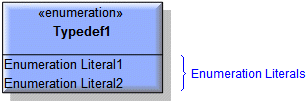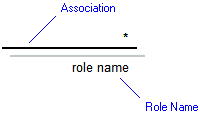Class diagram symbols
A Class Diagram can show Activities, Actors, Actual Template Parameters, Associations, Attributes, Basic Types, Call Behavior Actions, Central Buffers, Classes, Data Types, Dependencies, Enumeration Literals, Formal Template Parameters, Generalizations, Interfaces, IO Flows, Operations, Packages, Qualifiers, Roles, Signals, Ternary Associations, Ternary Roles, Type Definitions and Use Cases.
Actor
A Class Diagram shows Actors using the following notation.

For more information, see Actor (dictionary item), and Creating an actor.
Actual Template Parameter
Actual Template Parameters can be shown on a bind Dependency that is linked to a Package that has Formal Template Parameters defined.

For more information, see Actual template parameter (dictionary item), and Creating an actual template parameter.
Association
On a Class Diagram you can create Associations (and Aggregations) between Actors, Classes, Data Types, Interfaces and Signals.

For more information about Association, see the following topics:
Attribute
You can show the Attributes of Classes, Data Types, Interfaces and Signals on a Class Diagram.

Through the View Options of the owning item you can show or hide Attributes based on their Visibility.
For more information about Attribute, see the following topics:
Basic Type
A Class Diagram shows Basic Types using the following notation.

You can create an Attribute on an item (Class, Data Type, Interface or Signal) that uses a Basic Type as its type by creating a composite aggregation between the item and the Basic Type.
For more information, see Basic type (dictionary item), and Creating a basic type.
Call Behavior Action
When an Activity calls another Activity through a Call Behavior Action, a Class Diagram can show that Call Behavior Action as a composite aggregation symbol that links the two Activities.

For more information, see Call behavior action (dictionary item), and Creating a call behavior action.
Central Buffer
When a Class Diagram shows the Activity that owns an Central Buffer and the Class that is the type of that Central Buffer, you can show that Central Buffer as a composite aggregation that links the Activity to the Class.

When you show the properties of the composite aggregation, the Property Pages show the properties of the Central Buffer.
For more information, see Central buffer (dictionary item), and Creating a central buffer.
Class
A Class Diagram shows Classes using the following notation.

for more information on Class, see the following topics:
Data Store
When a Class Diagram shows the Activity that owns a Data Store and the Class that is the type of that Data Store, you can show that Data Store as a composite aggregation that links the Activity to the Class.

When you show the properties of the composite aggregation, the Property Pages show the properties of the Data Store.
For more information, see Creating a data store, and Data store (dictionary item).
Data Type
A Class Diagram shows Data Types using the following notation.

For more information, see Creating a data type, and Data type (dictionary item).
Dependency
A Class Diagram shows Dependencies using different notation for different Dependency types. The following notation is used when the Dependency type is Dependency.

The type of the Dependency determines which items can be linked by the Dependency.
For more information, see Creating a dependency, and Dependency (dictionary item).
Enumeration Literal
Enumeration Literals can be shown for Type Definitions that are of Enumeration construction.

For more information, see Creating a type definition, and Enumeration literal (dictionary item).
Formal Template Parameter
A Class Diagram shows a Package's Formal Template Parameters using the following notation.

For more information, see Creating a formal template parameter, and Formal template parameter (dictionary item).
Generalization
A Class Diagram can show Generalizations for showing inheritance between two Activities, Actors, Classes, Data Types, Interfaces, Signals and Use Cases.

For more information, see Creating a generalization, and Generalization (dictionary item).
Input Pin
When a Class Diagram shows the Activity that owns an Input Pin and the Class that is the type of that Input Pin, you can show that Input Pin as a composite aggregation that links the Activity to the Class.

When you show the properties of the composite aggregation, the Property Pages show the properties of the Input Pin.
For more information, see Creating an input pin, and Input pin (dictionary item).
Interface
A Class Diagram can show Interfaces as Interface, Required Interface or Provided Interface symbols.

For more information, see the following topics:
IO Flow
A Class Diagram can show an IO Flow as an IO Flow Link between items using the following notation.

When an IO Flow is a realized by an Association, a Class Diagram can show the IO Flow on the Association using the following notation.

For more information, see the following topics:
Operation
You can show the Operations of Classes, Data Types and Interfaces on a Class Diagram.

Through the View Options of the owning item you can show or hide Operations based on their Visibility.
For more information, see the following topics:
Output Pin
When a Class Diagram shows the Activity that owns an Output Pin and the Class that is the type of that Output Pin, you can show that Output Pin as a composite aggregation that links the Activity to the Class.

When you show the properties of the composite aggregation, the Property Pages show the properties of the Output Pin.
For more information, see Creating an output pin, and Output pin (dictionary item).
Package
A Class Diagram shows Packages using the following notation.

When you create an item within a Package on a Class Diagram, that item is scoped to the Package.
When you drag an item to within a Package, that item is scoped to the Package.
For more information, see Overview of packages, and Packages (dictionary item).
Qualifier
When Qualifiers are created for an Association, those Qualifiers are shown on a Class Diagram by default.

For more information, see Creating a qualifier, and Qualifier (dictionary item).
Role
An Association's Roles are shown by default on a Class Diagram.

Note that by default, an Association's Roles are unnamed.
For more information, see Creating a role, and Role (dictionary item).
Signal
A Class Diagram shows Signals using the following notation.

For more information, see Creating a signal, and Signal (dictionary item).
Ternary Association
A Class Diagram shows Ternary Associations using the following notation.

For more information, see Creating a ternary association, and Ternary association (dictionary item).
Ternary Role
A Class Diagram shows Ternary Roles using the following notation.

Note that Ternary Roles are created through the Association buttons; Modeler creates a Ternary Role when the start or destination item is a Ternary Association.
For more information, see Creating a ternary role, and Ternary role (dictionary item).
Type Definition
A Class Diagram shows Type Definitions using the following notation.

You can create an Attribute on an item (Class, Data Type, Interface or Signal) that uses a Type Definition as its type by creating a composite aggregation between the item and the Type Definition.
For more information, see Creating a type definition, and Type definition (dictionary item).
Use Case
A Class Diagram shows Use Cases using the following notation.

For more information, see Creating a use case, and Use case (dictionary item).